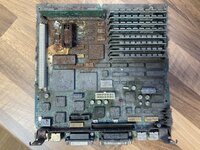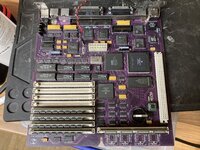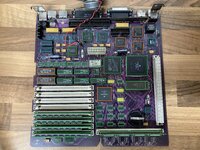TheMightyMadman
Active member
Hi all,
A few months ago, I bought my first Mac SE/30 sold-as-seen on eBay, figuring I'd take my chances on the condition of the battery.
I was unlucky this time, and the battery had bombed quite badly! The machine didn't make a start-up sound, and have horizontal stripes.
The original digital board wasn't really viable, so I bought a Bolle SE/30 PCB (fantastic work, Bolle and community!), and swapped the relevant parts over (including the ferrite beads on the rear of the board).
During this process, I socketed all of the DIP parts and the CPU, and have replaced quite a lot of parts too, including:
The power supply and analogue board tested OK with another digital board (which I had on loan from a friend).
The ROM SIMM also tested OK, but that was a while ago now, and the traces look a bit suspect.
I have no idea if the RAM SIMMs are good - the machine gives the same symptoms with all the RAM SIMMs removed, and the same again with either of the two sets of four fitted in the lower four SIMM sockets only.
I've burned a 2764 EPROM for the video ROM (using the .bin file attached), but there is no change in symptoms with that or the original ROM.
Please see below pictures of the board:
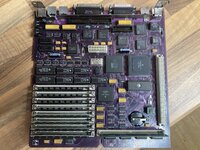
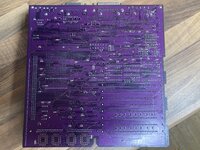
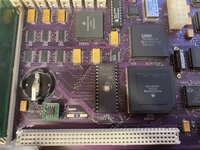

I'm not really sure where to concentrate on next, so I would appreciate some advice if anyone has any!
What typically causes these specific symptoms?
Adam
A few months ago, I bought my first Mac SE/30 sold-as-seen on eBay, figuring I'd take my chances on the condition of the battery.
I was unlucky this time, and the battery had bombed quite badly! The machine didn't make a start-up sound, and have horizontal stripes.
The original digital board wasn't really viable, so I bought a Bolle SE/30 PCB (fantastic work, Bolle and community!), and swapped the relevant parts over (including the ferrite beads on the rear of the board).
During this process, I socketed all of the DIP parts and the CPU, and have replaced quite a lot of parts too, including:
- All of the electrolytic capacitors (you know why).
- All three of the fuses.
- All eight of the RAM SIMM sockets (originals were poor quality).
- The ROM SIMM socket (original was battery damaged).
- The video ROM socket (original was battery damaged).
- The PDS connector (original was battery damaged).
- The RTC IC (swapped for an ATTinyRTC module), RTC crystal, battery holder, battery diodes (originals were battery damaged).
- The PAL ICs at UI6, UG6, UE6, UG7, UE7, UH7).
- The 74F258 RAM multiplexers at UI2, UI3, UI4, UJ2, UJ3, UJ4 (originals were battery damaged).
- The resistor packs at RP7, RP8, RP9 (originals were battery damaged).
- The 74F253 ICs at UA8, UB8, UC8, UD8 (originals hit by leaked electrolyte).
- The 74LS166 IC at UE8 (original hit by leaked electrolyte).
- The AM53C80 IC at UI12 (original hit by leaked electrolyte).
- The 8530 IC at UG12 (original hit by leaked electrolyte).
The power supply and analogue board tested OK with another digital board (which I had on loan from a friend).
The ROM SIMM also tested OK, but that was a while ago now, and the traces look a bit suspect.
I have no idea if the RAM SIMMs are good - the machine gives the same symptoms with all the RAM SIMMs removed, and the same again with either of the two sets of four fitted in the lower four SIMM sockets only.
I've burned a 2764 EPROM for the video ROM (using the .bin file attached), but there is no change in symptoms with that or the original ROM.
Please see below pictures of the board:




I'm not really sure where to concentrate on next, so I would appreciate some advice if anyone has any!
What typically causes these specific symptoms?
- I'm pretty sure all of my soldering is OK, but I will check everything over again, the PLCCs in particular.
- UF8 was also quite badly hit by leaked electrolyte, so I may replace UF8 and UG8 (both 74LS393s).
- I'll try and check continuity on the pins/traces/vias on the ROM SIMM.
Adam


